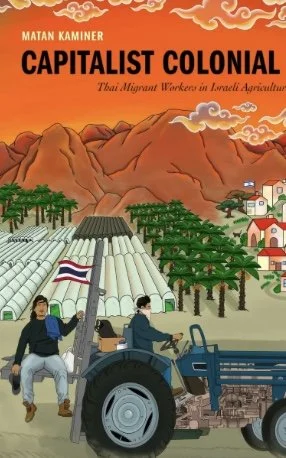Capitalist Colonial by Matan Kaminer (Stanford University Press) ~Janet Brown
In October 2023, 39 Thai farm workers were murdered in the Hamas massacre and 31 of them were taken hostage. Three of them died in captivity and not until early 2025 were all of the surviving Thai prisoners finally returned to their home country.
Although many were surprised at the presence of Thai laborers in Israel, this has been a reality since the early 1990s, with 20,000 Thai people employed in Israel by the middle of that decade. Most of them come from the impoverished northeast of Thailand, Isaan, which has been exporting labor to the Middle East and other countries in Asia as a way of keeping that region alive.
Israel maintains its imperiled borders by using agriculture. Kibbutz, cooperative farms, attracted volunteer labor in the 60s (probably as a result of the romantic ideal presented in Exodus, both the novel and the movie). When this source flagged, Palestinian labor took up the slack, until politics made this a hazardous move.
As Israel expanded its borders, more agriculture came into play and the southern wasteland of the area known as Arabah (“Wilderness” in local parlance) became an essential keynote of this policy. In their quest for cheap labor, Israeli politicians found allies in Thai employment brokers who began their export of workers from Isaan to another harsh corner of the world, the desert of Arabah.
Intrigued by this addition to his country, Israeli anthropologist Matan Kaminer quite literally began fieldwork to explore the world of Thai labor in Arabah. Diving first into the history of Israel’s agricultural movement and then into the economic disaster that exists in Isaan, Kaminer persuades a moshavim, a farm owner, to let him join the workers, all of whom are Thai except for Kaminer and an Israeli who is nominally the manager., although a Thai man is the actual foreman, due to linguistic and cultural barriers. With this team, Kaminer begins a workday that starts at sunrise and winds down at sunset, both in the fields and inside sweltering greenhouses. What he learns is limited by two factors: his coworkers’ lack of English or Hebrew and the Thai ingrained etiquette that keeps them from criticizing their superiors to outsiders. As an educated Israeli, with privileged access to his employer’s household, Kaminer faces an insurmountable barrier that is indelibly Thai.
Turning to interviews with former laborers who have returned to Thailand, Kaminer tríes to flesh out a picture of Thai workers on the Arabah’s moshav.
For Israeli farmers, Thai employees are close to perfect. Skilled farmworkers who also live on a frontier, accustomed to low wages and a low standard of living, they are deferential to authority and they arrive with a heavy debt to pay off to the brokers who have made their jobs possible. That, coupled with the traditional obligations to their parents, make them hard workers, desperate to keep their jobs.
Without an awareness of Israel’s labor laws, Thai workers receive less than the country’s minimum wage and are without the protection of health and safety regulations. While they make not much more than they would at home, they work under a contract that guarantees them five years and three months of a steady job. Although their contract keeps them from finding more lucrative employment, it also protects them from an early dismissal. Once they complete their contracts, Thailand gives them an easy route to return to their Israeli jobs by changing their names and receiving new passports. Job security and family pressure is the impetus for coming back, while the foreign exchange that comes from remittance payments keeps Isaan villages thriving communities.
Anyone looking for deep insights into Thai labor in Israel will be disappointed. Kaminer’s time in the field lasted for less than eight months. Much of his information comes from interviews within Thailand, through an interpreter. Although he hints at changes that take place in Thai labor behavior after years of being in Israel, while mentioning the difference between Thai behavior at work and during leisure hours at night, these are swiftly skirted over. His 269 pages consist of 75 pages of historical background and 92 pages of footnotes, bibliography, and an exhaustive index. Capitalist Colonial begins with promise but it remains a book that still waits to be written.
